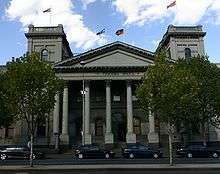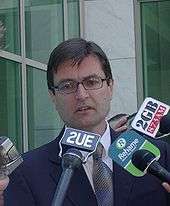Australian Council of Trade Unions
.png) | |
| Full name | Australian Council of Trade Unions |
|---|---|
| Founded | 1927 |
| Affiliation | ITUC |
| Key people |
Ged Kearney, President Dave Oliver, Secretary |
| Office location | Melbourne, Victoria |
| Country | Australia |
| Website |
www |
The Australian Council of Trade Unions (ACTU) is the largest peak body representing workers in Australia. It is a national trade union centre of 46 affiliated unions and nine trades and labour councils. The ACTU is a member of the International Trade Union Confederation.
The current President of the ACTU is Ged Kearney, and the current Secretary is Dave Oliver.
Organisation
The ACTU holds a biennial congress that is attended by approximately 800 delegates from affiliated organisations. Between congresses the ACTU is governed by an executive of 60 members: the president, the two vice-presidents, the secretary, the assistant secretaries, Trades and Labour Council representatives from each capital city and elected delegates from affiliated unions.
Objectives
The objectives of the ACTU, as stated in its constitution, are as follows:
- The socialisation of industry;
- Organisation of wage and salary earners in the Australian workforce (within the trade union movement);
- The utilisation of Australian resources to maintain full employment, establish equitable living standards which increase inline with output, and create opportunities for the development of talent.
Current campaigns
The ACTU's main focus since the 2007 Australian federal election has been its campaign to restore workers rights under the banner of the Your Rights at Work campaign [1] In addition to this campaign the ACTU is also running a number of other campaigns, including workplace health and safety,[2] working with other unions on the Your Rights at Telstra campaign and supporting the Rights on Site [3] campaign.
The ACTU has also launched a service by which workers can join their applicable union directly through the ACTU. This self-titled "one stop shop" for union membership is Australian Unions.[4]
In 2008, the ACTU launched a campaign to make paid maternity leave a new national employment standard.[5]
In 2011, the ACTU launched a campaign to address the spread of casual, contract and other forms of insecure work in Australian workplaces.[6] Part of this involved an inquiry into insecure work.[7]
History

In Australia, agitation for One Big Union took place from 1911 from two different sectors: from the revolutionary Australian section of the IWW and from the pro-arbitration Australian Workers Union (AWU). At that time the AWU was the largest single Australian union. In 1918 after the collapse of the Australian IWW, a group of militant trade unions (which were opposed to the AWU) attempted to form One Big Union under the name Workers Industrial Union of Australia (WIUA). The hostility between the WIUA and the AWU prevented the formation of One Big Union in Australia. The ACTU was formed in 1927 and was one of the earliest attempts by trade unions to apply the principles of One Big Union earlier explored by more radical syndicalist unions like the CNT or revolutionary industrial unions like the IWW. The ACTU has not achieved the ideals expressed for One Big Union: it remains a council organisation, but it does however represent the majority of Australian trade unions. At its formation in 1927 the ACTU was only seen as representing blue collar trades unions, and only managed to achieve the support of trades unions.
Attempts of Nationalist Stanley Bruce's federal government in 1927 to dismantle the Australian Industrial Relations Commission impelled Australian trade unions to form a national council. The ACTU's Australian trade union "peak body" precursors include state labour councils like the Victorian Trades Hall Council (originating in 1856 as the 'Melbourne Trades Hall Committee'), the Labor Council of New South Wales (originally formed in 1870 as the 'Sydney Trades and Labor Council') and the Inter-Colonial Trade Union Congress (formed in 1879).
From 1948 peak bodies of white collar associations existed, and from 1969 peak bodies of government employees. The white collar bodies were: the Council of Professional and Commercial Employees Association (1948), which became the Council of White Collar Associations (1954), which amalgamated with the Salaried Employees Consultative Council of New South Wales (1954) to become the Australian Council of Salaried and Professional Associations (ACSPA) in 1956. The government employee bodies were: the Council of Commonwealth Public Service Organisations (1969) which became the Council of Australian Government Employee Organisations (CAGEO) in 1975. The ACTU successfully integrated these bodies in 1981. After 1981 the ACTU was generally viewed by the Australian media and public as the organisation representing all workers' organisations.

The ACTU and Labour Councils have often united Australian working class opinion behind certain initiatives like the eight-hour day or compulsory arbitration. In the early 1980s this unifying impulse created an accord between government, capital and labour on wages and prices. The ACTU retains a close relationship with the Australian Labor Party: former ACTU President Bob Hawke went on to become the leader of the ALP and then Prime Minister of Australia. Other former ACTU Presidents who went on to become members of Federal Parliament are: Simon Crean (president 1985-90), Martin Ferguson (1990–96), and Jennie George (1996–99). The November 2007 election win by the Labor Party, saw the election of a number of union officials to the parliament (Commonwealth) including Bill Shorten (Australian Workers Union) and Greg Combet (former ACTU Secretary).
In the late 1980s and early 1990s the ACTU was influential in a move to forcibly amalgamate smaller unions into so called "super unions". The ACTU's plans envisaged 20 super unions organised on an industrial basis. While a large number of amalgamations occurred in the late 1980s and early 1990s (in part under the influence of changed industrial law), there are still a large number of unions, and union coverage is often organised by historical amalgamation, not by industry.
Past campaigns
In the lead up to the 2007 federal election, the ACTU campaigned actively against the Howard Government's WorkChoices legislation, which included an advertising campaign[8] and public rallies.[9] This campaign was originally called "Your Rights at Work" but is now known as "Secure Jobs. Better Future"[10] and was considered a success in making industrial relations an important election issue by both marketing companies[11] and even Joe Hockey MP, the Federal Workplace Relations Minister, who said "This is the most sophisticated political plan that we have seen in Australia.".[12] One of the rallies was called Fill the "G" , attended by 50,000 people at the Melbourne Cricket Ground and broadcast to other similar rallies throughout the country.[13][14] A previous national rally had a reported attendance of 500,000 around Australia.[15][16]
Affiliated trades and labour councils
|
|
Current affiliated organisations
See also
- 1998 Australian waterfront dispute
- Australian Industrial Relations Law Reform 2005
- Australian labour law
- Australian Workplace Agreement
- Employers' organization
- Enterprise Bargaining Agreement
- Fair Pay Commission
- Trades Hall
- Trade Practices Act
- Transport Workers Act 1928
- Unions ACT
- List of unregistered Australian unions
- Workplace Relations Act 1996
References
- ↑ Your Rights at Work - Home
- ↑ ACTU Health and Safety pages Archived 2 September 2008 at the Wayback Machine.
- ↑ "Rights on Site website". Rightsonsite.org.au. Retrieved 2010-07-20.
- ↑ Australian Unions. Retrieved 5 July 2013.
- ↑ Paid Parental Leave Archived 13 July 2013 at the Wayback Machine. ACTU. Retrieved 5 July 2013.
- ↑ (16 May 2012) Joe Kelly.ACTU out to reverse work 'casualisation', improve bargaining power. The Australian. News Limited. Retrieved 5 July 2013.
- ↑ Stoush brews over full-time job orders
- ↑ (14 July 2005) Heather Ewart. Ads argue the case for and against IR changes. 7:30 Report. Australian Broadcasting Corporation
- ↑ - Rally information from Campaign website Archived 12 February 2007 at the Wayback Machine.
- ↑ Secure Jobs. Better Future
- ↑ Campaign Results Archived 30 August 2007 at the Wayback Machine.
- ↑ "ABC transcript of radio interview with Joe Hockey". Abc.net.au. 13 June 2007. Retrieved 2010-07-20.
- ↑ Holroyd, Jane (30 November 2006). "IR laws 'just not cricket'". Melbourne: "The Age". Retrieved 2010-07-20.
- ↑ (30 November 2006) Reko Rennie. March stops city traffic. The Age.
- ↑ Thousands protest against IR laws. Australian Broadcasting Corporation. 15 November 2005.
- ↑ Protesters engulf Melbourne CBD. The Age. 15 November 2005. Cites 175,000 as Melbourne crowd size.
External links
- Official website
- ACTU Congress
- Unions Australia
- Industrial relations and the trade unions under Labor: from Whitlam to Rudd—World Socialist Website